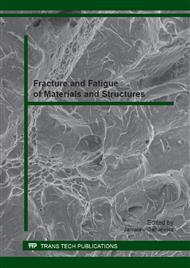[1]
S. Kocańda, J. Szala , Podstawy obliczeń zmęczeniowych. PWN, Warszawa 1989.
Google Scholar
[2]
S. Kocańda, A. Kocańda, Niskocyklowa wytrzymałość zmęczeniowa metali. PWN, Warszawa, 1989.
Google Scholar
[3]
J. Morrow, Cyclic plastic strain energy and fatigue of metals. International Friction, Damping and Cyclic Plasticity, ASTM STP, p.378, 1965.
DOI: 10.1520/stp43764s
Google Scholar
[4]
T. Łagoda, E. Macha, W. Będkowski, A critical plane approach based on energy concepts: Application to biaxial random tension-compression high-cycle fatigue regime. Int. J. Fatigue, Vol. 21, 1999, pp.431-443.
DOI: 10.1016/s0142-1123(99)00003-1
Google Scholar
[5]
S. Mroziński, Stabilizacja własności cyklicznych metali i jej wpływ na trwałość zmęczeniową. Rozprawy nr 128. Wydawnictwa Uczelniane Uniwersytetu Technologiczno-Przyrodniczego, Bydgoszcz 2008, p.148.
Google Scholar
[6]
Xu Chen, Dan Jin, Kwang Soo Kim, Fatigue life prediction of type 304 stainless steel under sequential biaxial loading, International Journal of Fatigue, Vol. 28 (2006), ss.289–299
DOI: 10.1016/j.ijfatigue.2005.05.003
Google Scholar
[7]
S. Manson, G. Halford, Practical implementation of the double linear damage rule and damage curve approach for treating cumulative fatigue damage. Int. Journal Fracture, Vol. 17, 1981, p.169–192.
DOI: 10.1007/bf00053519
Google Scholar
[8]
I. Memon, X. Zhang, D. Cui, Fatigue life prediction of 3-D problems by damage mechanics with two-block loading. International Journal of Fa-tigue, Vol. 24, 2002, p.9 – 37.
DOI: 10.1016/s0142-1123(01)00057-3
Google Scholar
[9]
R. Pawliczek, C.T. Lachowicz, The mean stress effect on fatigue behavior of constructional steels subjected to variable amplitude bending, 2nd International Conference on Material and Component Performance under Variable Amplitude Loading, Eds C.M. Sonsino and P.C McKeighan, DVM, Berlin, 2009, pp.1095-1102.
DOI: 10.1520/stp11294s
Google Scholar
[10]
R. Pawliczek, Trwałość zmęczeniowa próbek ze stali 18G2A w warunkach blokowych obciążeń zginających z wartością średnią, Zeszyty Naukowe Politechniki Opolskiej Nr 305/2005, Mechanika Z. 83., Opole 2005, pp.167-174
Google Scholar
[11]
R. Pawliczek, Wpływ wartości średniej w obciążeniach blokowych na kształt pętli histerezy przy zginaniu próbek ze stali S355, Przegląd Mechaniczny, Nr 2, 2013, pp.32-36
Google Scholar


